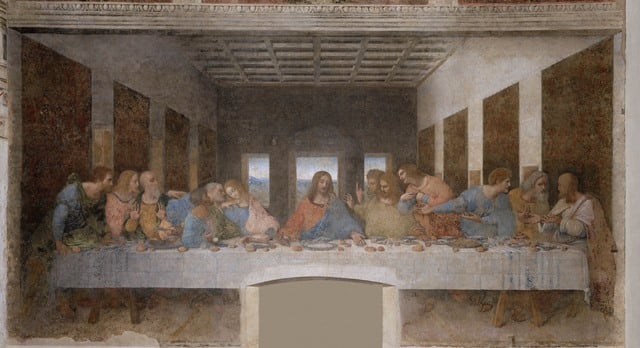
Leonardo da Vinci’s Last Supper (c. 1495-98) which shows the final meeting of Jesus and the 12 apostles, is one of the world’s most famous artworks.
It has been analysed time and time again, its true cast of figures has been questioned, has been found to contain hidden astrological messages, and in 2007 a University of Oxford doctorate candidate found that the masterpiece was also holding a musical secret: a hidden hymn coded in the bread.
Giovanni Maria Pala, an Italian musician, computer technician, and at the time student at Magdalen College, had been fascinated by Leonardo and The Last Supper for years.
He began examining the straight row of scattered pieces of bread that ran along the iconic table, which were present in the banquet as a symbol of the body of Christ.
What Pala found was that, when paired with the hand-placement of the 13 figures, the bread spelled out a haunting 40-second melody when the painting was overlaid with a standard five-line musical staff.
The melody is played right-to-left, which is how Leonardo wrote down many of his ideas in the name of secrecy. He was left-handed and would write both left-to-right and backwards, making his personal books decipherable only in a mirror.
The hidden hymn (played here in 2010) adds to the tense mood in the biblical story, when Jesus anticipates his betrayal by Judas. Pala says that the requiem is best played on the pipe organ, an instrument popular in Leonardo’s day for this type of music.
But why did the artist bother? The painting was commissioned by the Duke of Milan, Ludovico Sforza, for the Dominican convent of Santa Maria della Grazie (where the painting still lives), so he would have been positive that the painting would be looked at and cared for in the long term.
Fellow Leonardo expert and art critic Alessandro Vezzosi called Pala’s hypothesis “plausible”. The discovery isn’t an outlandish one, especially as the 15th-century polymath was already recognised as a talented musician and instrument-maker, as well as a master painter (and mathematician, and engineer, and architect, and botanist, and palaeontologist, and astronomer… that’s polymaths for you.)
It might not have hit the charts, but the hidden hymn certainly continues his legacy as a multi-talented genius, and might get a mention if there’s ever a Da Vinci Code sequel from Dan Brown.





